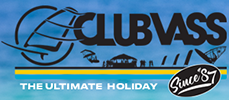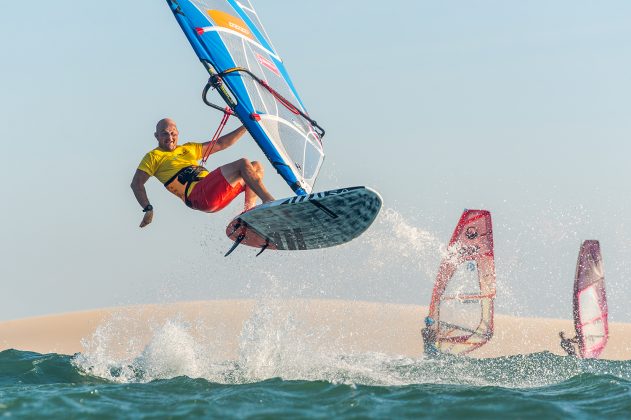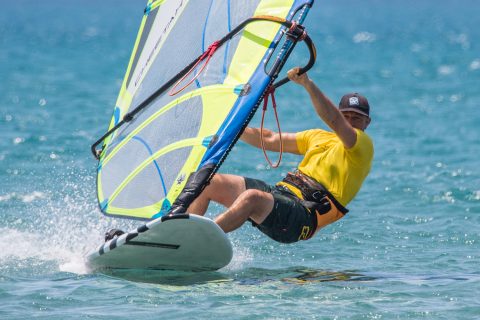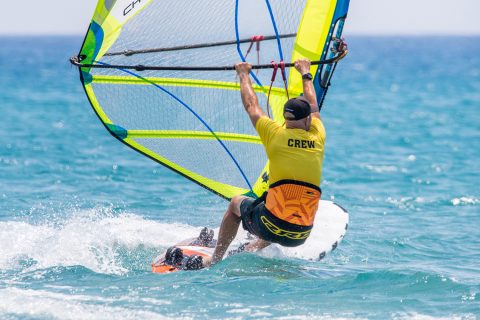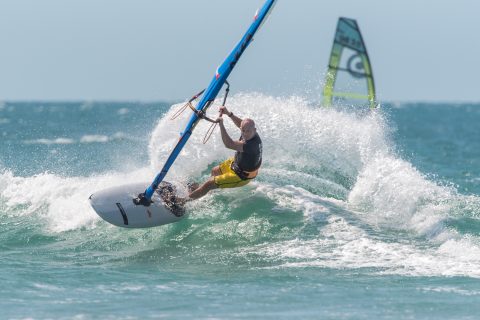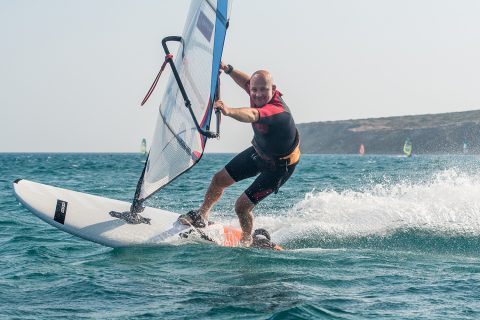JEM HALL
MOVE ON UP – WINDSURFING TECHNIQUE
QUALITY NOT QUANTITY
MOVE ON UP – with Jem Hall
Photos by Eye Sea You Photo
From our August edition of Windsurf Magazine Jem Hall discusses quality of quantity.
We all want to enjoy our sailing, and perhaps improve a tad too. Sometimes we can be starved of time on the water, so when we get some we binge on it and whilst this can be fun, it can also be very counterproductive for improving and learning. For over 25 years now, both through freesailing and coaching, I have seen the benefits of shorter more focussed / higher tempo sessions on the water, or what I like to call an “hour of power.” You may have a few of these in a day, but believe me these are a far cry from 2 hours or longer of massive long reaches (groove riding) and lots of standing around in the shallows. I aim to outline how to inject more quality into your sessions, and why indeed you should, showing you the benefits of this strategy and lastly suggest when a bit of quantity can help you. Your new mantra may be well become, ‘I need more effective time on the water’, not the oft-quoted, ‘time on the water’.
WHY QUALITY
- Physically Windsurfing is very physical and therefore after a good amount of time on the water we will become less able to maintain the strength and endurance required to sail well. When we get tired we sail slower, as we stand up more, and so the sail becomes more loaded and hard to control and less easy to handle in gybes, for example. If we sail for less time in each session then we can sail faster, have more fun and likely will make more moves.
- Mentally This is perhaps the part that makes the most difference. If we sail for too long we can begin to make poor decisions and pay less attention to the wind and the waves, all three will affect our performance. I can feel when I am starting to become less focussed and when I make a mistake or two it is time to get off the water and more often than not this is after an hour of power.
- Improvement Some of the moves we look to acquire, or improve in, are quite technical and physical, for example the carve gybe and the waterstart. The latter is best worked on in 20-minute batches, as after that performance deteriorates rapidly and we begin practicing our mistakes!
- Damage limitation By ‘oversailing’ and then experiencing the deficiencies listed above in our performance, we might then start to crash, which can then injure us, or damage our gear.
- Self-coaching When we come in from an hour of power for a break, we not only get time to refuel and tune, but our brain gets a break too. In this period we can be both consciously and subconsciously analysing our performance, as this is difficult to do in the heat of battle.
- Spending more time unhooked can really up your quality in gybe preparation, which in turn will better your gybes.
UPPING QUALITY FOR INTERMEDIATES
If you are looking to improve your speed, tweak transitions and extend your wind range, you can do this by:
- Super starts – clearing the rig faster, and getting out of the water quicker by working harder with legs and arms. This is opposed to taking your time and waiting for a big gust to do all the work.
- Sailing faster – this means getting lower in the gusts and yes this is way more physical and it is why we should not ‘oversail’. It also means keeping speed in the lulls by having the mental fitness to spot gaps in the wind and then weight your toes and lean forward more. Faster sailing means a lighter rig, which is then easier in many moves. This speed also produces more lift on the fin so we can get upwind and try more moves.
- Shortening your reaches – if we sail for less distance in a straight line, then over the course of an hour we can try more tacks and gybes and thereby have more attempts in which to build progress. If we sail shorter reaches we will also have to work harder to plane earlier and sail faster so we can get upwind, and this will really both challenge and improve your skills and put you in a better position to try harder moves, or get into waves.
- Do more reaches – if your standard day includes a long blast out and then back to the beach for a rest and a chat, then think again and aim to do at least eight to ten reaches in and out without a break. If you need to tune, do it quickly.
- Get physical – unhook earlier into your tacks and gybes and then rehook again later, as opposed to hooking in straight after a tack or gybe. This will massively boost your entrance and exit skills and give you some much needed fitness that can be used for harder moves / sessions or for aspiring to be a wave sailor.
- Planing gybe exits come from being unhooked, and this may then mean attempting less of them.
BOOSTING QUALITY FOR ADVANCED RIDERS
If you are looking to carry more speed in and out of turns, get in the air and add a few more moves to your repertoire, you can do this by:
- Getting fitter – this comes both from sailing in the way I outlined for intermediates, but also from extra strength and fitness work.
- Trying more moves – this might be trying chop hops or attempting your first duck gybes, as opposed to just talking about them.
- Going both ways – when learning / improving a new move, like a chop hop, it is best to work on it both ways. I will cover this at more length in a future piece. I learnt to forward loop in 1996, I tried it both ways, it was ropey on port tack, but got better and this definitely helped me improve my slightly better starboard tack loops.
- Moving out of your comfort zone – you may already be making some nice dry gybes, but if they are to improve and become planing, then you will have to ‘get on the front foot’ and take the inevitable falls this will deliver on your new pathway. Or you may already be jumping nicely, so now it is time to do it hooked in and try dropping a hand.
- Taking time to tune – in order to make harder moves, you need to make some decisions on your kit and (quickly) tune it. This might be changing down a fin for better carving, or moving the mastfoot back for more pop. The opposite of this is sailing for too long, badly, and with poorly tuned gear.
- In Jeri many people fly along the wave doing lots of turns, when actually it is best to focus on two good quality turns.
INJECTING MORE QUALITY IN YOUR WAVE SAILING
These tips are for those looking to make more jumps, perhaps go higher and are also ready to loop. On the way in they desire to ride good waves and make some nice turns on them. They have an entrance and exit plan to get them onto a wave or off it. How can we boost all of this?
- Learn and improve your tacking – this transition gives you more choices and gets you more upwind so you can do a lot more jumping and riding. It also means you can tack onto a wave for a smooth entry and then be upwind for a longer ride.
- Sail shorter reaches – I am often astounded by how far out some people sail in a wave break when they can easily get upwind and do not need to be so far out to catch a wave. Work harder to get upwind when you have good wind and power and use the swell / wave on the way in to take you upwind.
- Absorb and attack – get your speed up on the inside and decide what ramps to absorb, or take a long fast jump off, and what ramps to attack and send it for some height or rotation. My back loops got better when I tried less but chose better waves.
- Choose better waves for riding – this may mean waiting out the back at the ‘bus stop’ for longer, even when windy, or having the mental fitness and observation to read the ocean better.
- Don’t milk it – wave riding is amazing and so people want to make as many turns as possible. Yet I find it is better to concentrate on two, maybe three turns, at a time. We can then put a lot more energy and focus into these turns and in effect they will then be better. We could then stall on the wave, wait, reflect and go again, it would be rude not to!
- Have an exit plan – don’t just ride that ripple all the way to the sand and fall in, see a softer part of the wave that you can gybe off and do just that. Then you can get out the back and have the energy for some good turns on your next decent set wave.
- Working on your outside gybe is best done after a shorter reach out, so you can try more of them.
TIME FOR SOME QUANTITY
Whilst I am a strong advocator of quality over quantity, there are also occasions when you can put in that extra thirty minutes or try a move more times. Here is when I feel it is best put in a little more:
- Gaining Fitness Early in the season you put in some hours of power, but as you begin to feel fitter and are looking to move forward, then it can be good to add some ‘extra time’, in order to tax yourself. This may be 20 – 30 minutes extra of blasting, or a few more jumps. However, ensure you lower your aspirations and take it a bit easier so as not to push yourself too much.
- Learning a new move Some of my people say they tried a move on the water and I ask them how many times and they might answer with a low single digit number. If you want to perfect new moves, then you have to get in more attempts than you might think! I wanted to boost my aerials and so by trying 15-20 over 90 minutes they got better.
- When it feels right During those sessions where everything is flowing and you feel good, and are perhaps enjoying your session with friends, then just go with that flow and keep sailing. If it is good conditions for wave sailing and I want to stay out, I take it down a notch on the jumps and just look to catch a few more waves to ride and look to bang out some nice turns for example.
Ezzy sails, RRD (boards, wetsuits & softwear), Chinook & Black Project fins sponsor Jem Hall. Get him live and direct on one of his highly acclaimed coaching holidays – check out his website www.jemhall.com for details. You can also follow him on twitter / Facebook / Instagram.

